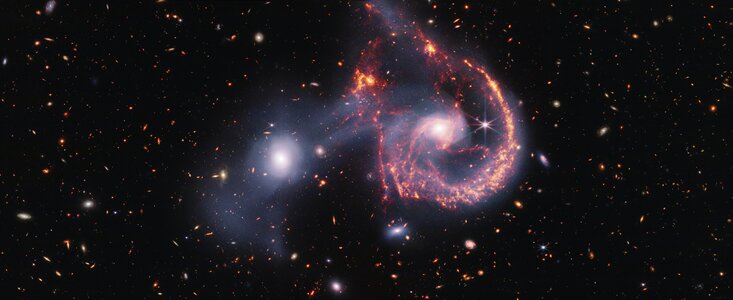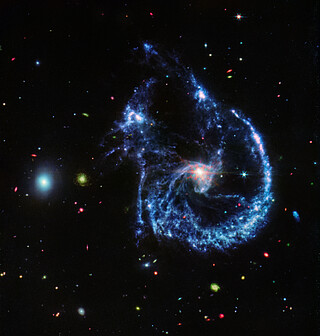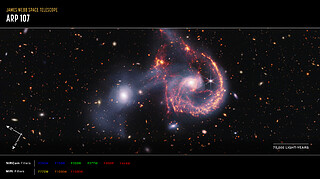weic2423 — Photo Release
Webb provides another look into galactic collisions
18 September 2024
An interaction between an elliptical galaxy and a larger spiral galaxy, collectively known as Arp 107, seems to have given the spiral a happier outlook thanks to the two bright ‘eyes’ and the wide semicircular ‘smile’ that have resulted. This image is a composite, combining observations from Webb’s MIRI (Mid-InfraRed Instrument) and NIRCam (Near-InfraRed Camera).
NIRCam highlights the stars within both galaxies and reveals the connection between them: a transparent, white bridge of stars pulled from both galaxies during their passage. MIRI data, represented in orange-red, show star-forming regions and dust that is composed of soot-like organic molecules known as polycyclic aromatic hydrocarbons. MIRI also provides a snapshot of the bright nucleus of the large spiral, home to a supermassive black hole.
The spiral galaxy is classified as a Seyfert galaxy, one of the two largest groups of active galaxies, along with galaxies that host quasars. Seyfert galaxies aren’t as luminous or as distant as quasars, so they are better places to study similar phenomena in lower-energy light, like infrared.
This region is much like the Cartwheel Galaxy, one of the first interacting galaxies that Webb observed. Arp 107 may have turned out very similar in appearance to the Cartwheel, but since the smaller elliptical galaxy had an off-centre collision instead of a direct hit, the spiral galaxy got away with only its spiral arms being disturbed.
The collision isn’t as bad as it sounds. Although there was much star formation occurring before, collisions between galaxies can compress gas, improving the conditions needed for more stars to form. On the other hand, as Webb reveals, collisions also disperse a lot of gas, potentially depriving new stars of the material they need to form.
Webb has captured these galaxies in the process of merging, which will take hundreds of millions of years. As the two galaxies rebuild after the chaos of their collision, Arp 107 may lose its smile, but it will inevitably turn into something just as interesting for future astronomers to study.
Arp 107 is located 465 million light-years from Earth in the constellation Leo Minor.
More information
Webb is the largest, most powerful telescope ever launched into space. Under an international collaboration agreement, ESA provided the telescope’s launch service, using the Ariane 5 launch vehicle. Working with partners, ESA was responsible for the development and qualification of Ariane 5 adaptations for the Webb mission and for the procurement of the launch service by Arianespace. ESA also provided the workhorse spectrograph NIRSpec and 50% of the mid-infrared instrument MIRI, which was designed and built by a consortium of nationally funded European Institutes (The MIRI European Consortium) in partnership with JPL and the University of Arizona.
Webb is an international partnership between NASA, ESA and the Canadian Space Agency (CSA).
Image Credit: NASA, ESA, CSA, STScI
Links
Contacts
Bethany Downer
ESA/Webb Chief Science Communications Officer
Email: [email protected]
Ninja Menning
ESA Newsroom and Media Relations Office
Email: [email protected]
About the Release
| Release No.: | weic2423 | |
|---|---|---|






